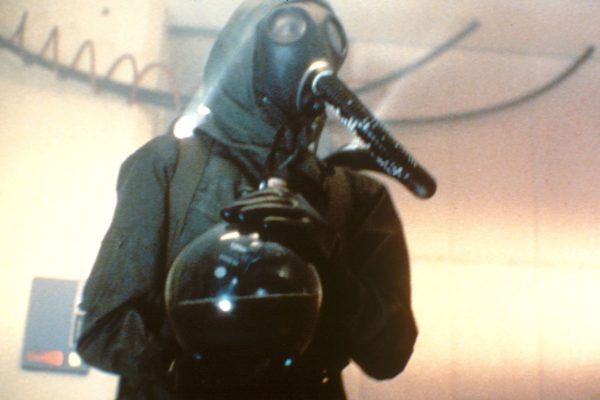On Blu-ray from Mon 6 May 2019
Roger Corman is an icon of independent cinema for his ability to turn limited resources into assets. This thriftiness as a producer and mentor helped to launch the careers of Francis Ford Coppola, Martin Scorsese and James Cameron, as well as many less successful but arguably just as interesting filmmakers. One of these is Belgian-born Carl Colpaert, whose debut is a bizarre mash-up of micro-budget post-apocalyptic drama with the surrealist, metaphysical anime Angel’s Egg. Sadly, while an intriguing prospect, the execution is sorely lacking despite a few evocative scenes.
In the live-action scenes, two soldiers are attacked while on a salvage mission through an old industrial zone. One is killed, while the survivor begins to have odd sightings of a strange little girl wandering through the contaminated area clutching a giant egg. The anime sections reveal her to be a literal angel, with a vague mission to use the egg to help someone who may be deserving.
These sections lifted directly from Ghost in the Shell director Mamoru Oshii‘s animated puzzle, use the notoriously obtuse musings on hope and faith to sketch a ponderous environmental screed that tries to mask vagueness as profundity. On an aesthetic level, you can’t help but notice the clash between the gorgeous, sparse hand-drawn craft of Angel’s Egg and the ugly tobacco-stained scenes filmed by Colpaert. Stilted performances don’t help the appreciation of the live-action sections. Lead actor Tony Markes could charitably be said to do a passable rendition of someone dazed and hollowed-out by their circumstances, although it’s more likely a grinding collision of bad writing and wooden acting.
Where In the Aftermath does succeed is in creating little moments of atmosphere that transcend its limitations. The most striking is a scene in which Markes (clad in a gas mask) plays a pretty Horacio Moscovici tango on a piano. This is edited in a montage with snippets of the anime superimposed over his recital and his falling in love with a doctor (Filiz Tully) who treats his injuries. It’s one of the few moments that matches Colpaert’s ambition and which manages to combine the live action and animation in a way that feels symbiotic and not gimmicky.
These hints of something better merely make this generally flawed attempt at marrying two disparate elements all the more disappointing. It’s an initially intriguing curio that feels like it exists more to showcase the early work of a famous figure in Japanese animation than as a complete and coherent work in its own right. Is it homage or vandalism? Wherever one falls on its existence, no one is likely to be entirely satisfied with the end result.
